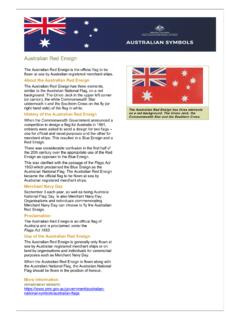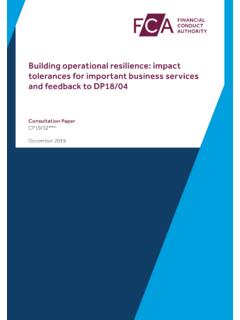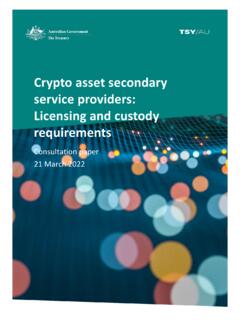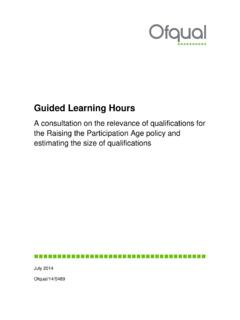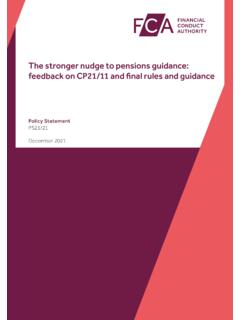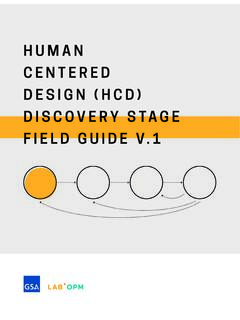Transcription of Best Practice Consultation Guidance Note
1 Best Practice Consultation 1 BEST Practice Consultation February 2016 Introduction Of the 10 principles for Australian Government policy makers in the Australian Government Guide to Regulation, two are related to Consultation : 5. policy makers should consult in a genuine and timely way with affected businesses, community organisations and individuals. 6. policy makers must consult with each other to avoid creating cumulative or overlapping regulatory burdens. A genuine Consultation process ensures that you have considered the real-world impact of your policy options. This is likely to lead to better outcomes and greater acceptance in the community, particularly among any stakeholders who may be adversely affected by the policy .
2 Question 5 of the seven Regulation Impact Statement (RIS) questions in the Guide to Regulation asks; Who will you consult about these options and how will you consult them? In the Consultation section of the RIS, you must: explain the purpose and objectives of Consultation outline a plan for conducting Consultation explain who should be consulted and who does not need to be consulted outline a strategy for the most efficient and meaningful Consultation summarise the major topics to be covered and what issues might be raised. This Guidance note provides additional detail on the application of the whole-of-government Consultation principles outlined in the Guide to Regulation, as well as the role of the Office of Best Practice Regulation (OBPR) in encouraging best Practice Consultation processes.
3 Best Practice Consultation and the RIS process A RIS is required to demonstrate that appropriate Consultation has been undertaken. It will not be considered adequate at Final Assessment if no Consultation has taken place, including Consultation with other policy makers. Consultation plays an important role in ensuring that every practical and viable policy alternative has been considered. Stakeholders and those closest to a problem can sometimes suggest useful ways to solve it. Your RIS should therefore reflect the feedback received on all genuine and viable options. Best Practice Consultation 2 Consultation is particularly important in helping agencies to quantify the regulatory burden of proposed regulatory measures on businesses, community organisations or individuals.
4 The burden should be estimated before a Final Assessment of the RIS is undertaken. There are four Consultation options that you can take when developing the RIS: full public, targeted, confidential or post-decision. Full public Consultation is the appropriate level of Consultation for all proposals unless you make a compelling case for a limited form of Consultation (such as a need for confidential Consultation because of market sensitivity). Be aware of the effort required from individuals and businesses to participate in consultations. You should take advantage of the synergies possible with joint Consultation with other agencies.
5 Australian Government agencies should also engage with state and local governments to benefit from shared experiences. Each portfolio has a Regulatory Reform Unit, which should be the first point of contact when you are considering your Consultation process (including your choice of Consultation option). The Regulatory Reform Units are well placed to advise you of policy development processes within your portfolio and in other portfolios that may be targeting the same stakeholders as your proposed policy . Each portfolio has also established a Ministerial Advisory Council. The councils consist of business, community organisations and other stakeholders, and can provide a broader Consultation mechanism on policy matters.
6 Online technology can increase your engagement with individuals and enhance collaboration in policy making. Information is available in the Australian Government s Web Guide (Web ) outlining the various tools available for low-cost and wide scale online Consultation . Web can supplement consultations with online engagement and participation. The Australian Government s Business Consultation website ( ) makes it easier for agencies to post Consultation information and for stakeholders to supply feedback . Application of Consultation processes Continuous Consultation with key stakeholders should be continuous and should start as early as possible.
7 It should continue through all stages of the regulatory cycle, including when detailed design features are being finalised. This will help you to identify and understand potential problems. For example, Consultation before submitting the RIS for Early Assessment may help to define the problem, objectives and options, and to quantify the associated regulatory burden, thereby improving the quality of the RIS. Broad-based Consultation will also help to identify the risks of regulatory capture, which occurs if the regulator ends up acting in ways that benefit the industry that it is supposed to be regulating, rather than the public.
8 Agencies responsible for providing policy advice to the Government should also consult the relevant regulators to ensure that regulations can be administered in a manner that is consistent with the Government s intent. Regulators should consult key stakeholders to understand the potential impacts of regulation on their operations. Best Practice Consultation 3 Broad-based You must consider the scope of the proposed regulatory changes and consult widely to ensure that Consultation captures the diversity of stakeholders affected by the changes. Relevant individuals and groups may include: the general public businesses, consumers, unions, environmental groups and other interest groups state, territory and local governments Australian Government departments, agencies, statutory authorities and boards.
9 It may be appropriate for you to distinguish between stakeholders within these main groups where the impacts of options are likely to differ. For example, the views of businesses may vary depending on their size, nature of operations or location. For Consultation with business stakeholders, a good starting point may be industry associations and small business groups. However, they might not represent all stakeholders in a particular sector. Furthermore, large industry associations with diverse memberships might not have a consistent view on all aspects of a regulatory proposal.
10 You should consider the best way to engage individual stakeholders in the Consultation . For community stakeholders, such as consumers, environmental groups and other interest groups, peak bodies may also be a starting point. However, these bodies might not represent all relevant stakeholders, so individual stakeholders should be included in the Consultation where appropriate (s ome agencies already have mechanisms to consult individuals). Online consultations can assist engagement with the community through the use of social media tools, such as social networking sites or blogs.






